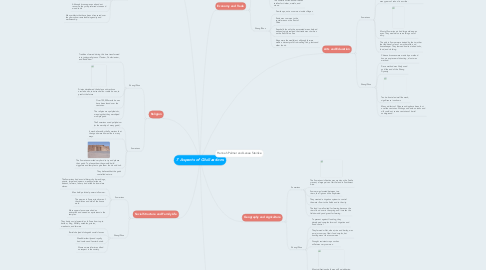
1. Science and Technology
1.1. Sumerians
1.1.1. The also leaned how to use geometry which helped them build large structures.
1.1.2. They created an irrigation system that helped keep their fields fertile.
1.1.3. The Sumerians used bronze to make stronger tools and weapons.
1.1.4. They also had a pretty large amount of medical knowledge and preformed basic surgery on people.
1.2. Shang/Zhou
1.2.1. Bronze was used to make tools, and weapons
1.2.2. Domesticated animals such as cows, sheep, dogs.
1.2.3. Although bronze was an abundant resource, they still preferred stone and wood tools
1.2.4. Many artifacts that have been discovered over the years show remarkable ingenuity and workmanship
2. Social Structure and Family Life
2.1. Sumerians
2.1.1. The Sumerians had a social hierarchy. It was kings, priests, large land owners, wealthy merchants, artisans, farmers, labors, and at the bottom were slaves.
2.1.2. Men held polotical powers in Sumner.
2.1.3. The women in Sumner took care of the children and did all the house work.
2.1.4. More upper-class women had an education and served as a priestess in the temples.
2.2. Shang/Zhou
2.2.1. They had a social pyramid as follows from top to bottom; King, Military notables, priests, merchants, and farmers
2.2.2. Burials helped distinguish social classes
2.2.3. Wealthier family sand royalty had tombs and fancier burials.
2.2.4. Women were inferior and had no respect in the society
3. Religion
3.1. Shang/Zhou
3.1.1. Traditions formed during this time transformed into todays religions of Taoism, Confucianism, and Buddhism.
3.1.2. Priests deciphered the holes and cracks on oracle bones, tortoise shells or cattle bones, to predict the future
3.1.3. Over 150,000 oracle bones have been found over the centuries.
3.1.4. The religion was polytheistic, meaning that they worshiped multiple gods.
3.2. Sumerians
3.2.1. The Sumerians used polytheism (or the worship of many gods).
3.2.2. It was believed by the Sumerians that their gods were human like in many ways.
3.2.3. The Sumerians worked very hard to try and please their gods. To please them they would build ziggurats and temples to give them food and drink.
3.2.4. They believed that the gods controlled nature.
4. Economy and Trade
4.1. Sumerians
4.1.1. When Sumerians are building their cities and producing art they got most of there items through trade.
4.1.2. Sumner didn't have a lot of the important raw materials like wood and metals.
4.1.3. They traded with many people in Southwest Asia and other people in surrounding areas.
4.1.4. The Sumerians traded their woven textiles for timber, metals, and stone.
4.2. Shang/Zhou
4.2.1. Few shops, not as common inside villages
4.2.2. Trade was common to the costal areas on the East of China
4.2.3. Sea shells found in the excavated areas, helped archaeologists realized that trade was common on the East China Sea
4.2.4. Kings were the wealthiest, although farmers made a decent profit from selling fish, plants and other foods.
5. Geography and Agriculture
5.1. Sumerians
5.1.1. The Sumerian civilization was made on the Fertile cresent, a large peice of fertile land in Southwest Asia.
5.1.2. Sumner was located between two rivers, the Tigris and the Euphrates.
5.1.3. They created a irrigation system to control the water flow to the fields and to the city.
5.1.4. The land is well suited for farming because the rivers flood over in the spring and it makes the fields muddy and great for farming.
5.2. Shang/Zhou
5.2.1. To prevent against flooding, they developed complex forms of irrigation and flood control
5.2.2. They farmed millet, wheat, rice and barley, was a major source of their food surplus, but hunting wasn't that uncommon.
5.2.3. Drought resistant crops such as millet was very common.
5.2.4. Most civilizations built around 2 neighboring rivers (Yangtze river and the Hwang He river)
6. Government and Leaders
6.1. Sumerians
6.1.1. In Sumner the priests held a high status and basically goveded the city-states.
6.1.2. The city-states fought for dominance and eventually the War Chiefs took the place of the priests as the city-states ruler.
6.1.3. The kings that ruled during that time preformed many ceremonies for the gods.
6.1.4. Dynasties were eventually formed by the city-states rulers. A dynasty is a line of rulers from one blood-line.
6.2. Shang/Zhou
6.2.1. Kings, and emperors ruled during the Shang and Zhou dynasty
6.2.2. People competed for employment by explaining social, military, economic and political views.
6.2.3. King Wen was the first king during the Zhou dynasty
6.2.4. Government mainly consisted of regional leaders and wealthy land owners
7. Arts and Education
7.1. Sumerians
7.1.1. They invented the wheel to help make pottery. The wheel also helped with the making of a variety vehicles.
7.1.2. The Sumerians had basic schooling systems. One of the things you could become if you took many years of school is a scribe.
7.1.3. Most of Sumerian art had large wide-open eyes. They would also carve things out of ivory.
7.1.4. The girls in Sumner were trained by their mother the traditional roles of a mother,wife, and housekeeper. They learned how to make drinks, food, and clothing.
7.2. Shang/Zhou
7.2.1. Chinese bronzes were made by a method known as piece-mold casting, a lost wax method.
7.2.2. Piece method was likely used until the end of the Shang Dynasty
7.2.3. Taotie- frontal animal like mask; significance is unkown
7.2.4. Many artifacts of Chinese writing have been lost over the centuries. Writings on bamboo sticks and silk could not survive centuries of burial underground.
